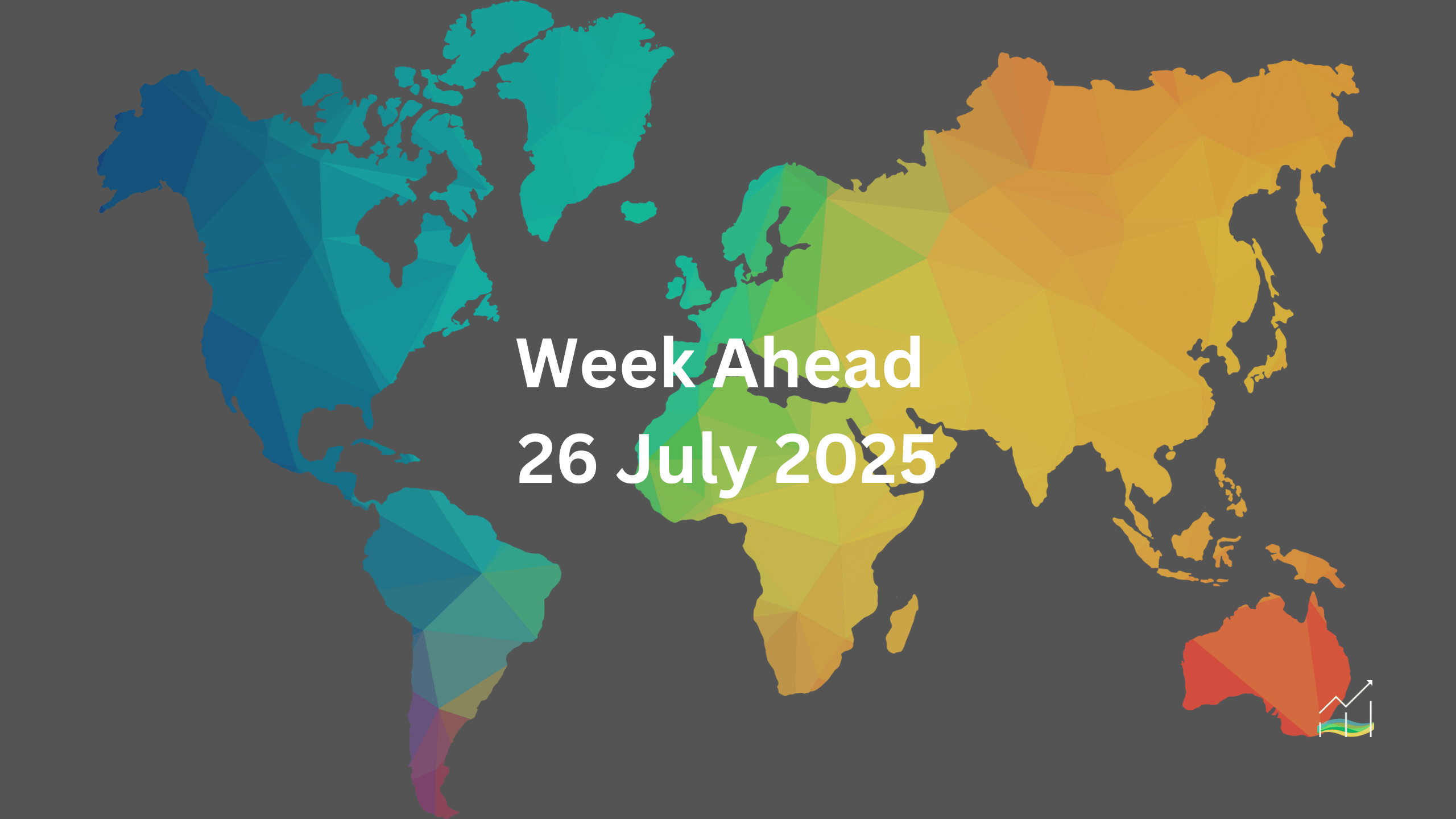26/07/2025 Week Ahead

Pivotal Week Ahead with Central Banks, GDP & Trade Risks
Key Takeaways:
- The US dollar's rebound may not be complete despite recent pullbacks.
- A highly eventful week ahead with three major central bank meetings.
- Key economic data includes US and eurozone Q2 GDP, US PCE deflator, and eurozone CPI.
- High-level political and trade developments may influence market sentiment.
- US labor market slowdown contrasts with the dollar’s technical setup.
After a retracement from its early July lows, the US dollar’s upside correction appeared to peak around July 17. While last week's pullback was expected, current price action suggests the correction may still be in progress. This raises questions as technical signals remain bullish, yet fundamental pressures are building against the greenback.
The coming week is packed with major economic and policy events, making it one of the most pivotal stretches of the year. The Federal Reserve, Bank of Japan, and Bank of Canada will all hold policy meetings. At the same time, first estimates for second-quarter GDP from both the US and eurozone will be released. The eurozone will also publish preliminary July inflation data, while the US PCE deflator, its preferred measure of inflation, will attract close attention.
Adding to the volatility risk, US President Trump is scheduled to meet European Commission President von der Leyen to potentially conclude a trade agreement. This is followed by high-level US-China talks in Stockholm early in the week, where the US may propose extending the current tariff truce for another 90 days from August 12. The week closes with the July nonfarm payrolls report and the expected end of the “reciprocal tariffs” delay on Friday, August 1.
These developments create a complex backdrop. The Fed appears to be inching closer to resuming rate cuts, while labor market data continues to lose momentum. Reconciling this deteriorating macro picture with an optimistic dollar outlook may become increasingly difficult.
United States of America
Overview
The US dollar continues to respond to evolving expectations around Federal Reserve policy, though its relationship with interest rates is not always linear. Broader market sentiment and geopolitical developments frequently exert stronger influence than rate moves alone. At present, the dollar remains broadly sensitive to Fed expectations, while the USD/JPY exchange rate, in particular, is tracking closely with shifts in the 10-year US Treasury yield.
This coming week is one of the most event-heavy periods on the US economic calendar. The Federal Reserve meets, though it is widely expected to hold policy steady. The more critical aspect lies in the tone of the statement and any dissents from voting members. Governor Waller and possibly Governor Bowman may express concern about the labor market, which would highlight internal divisions.
In terms of data, the focus is on Q2 GDP, expected to be the last quarter with growth above 2.0% for some time. Personal income and consumption figures will also be released, and markets will scrutinise the accompanying deflators, given the recent upside surprises in CPI and PPI. At the end of the week, non-farm payrolls will dominate attention. Consensus expects a slowdown in job creation to around 100,000 and a possible uptick in the unemployment rate.
Other important developments include the release of June trade figures, which show a widening shortfall compared to H1 2024, likely due to pre-emptive actions ahead of tariff threats. The US Treasury’s quarterly refunding announcement will be significant as it prepares to issue $183 billion in coupons alongside a larger amount of bills. Legal developments on the International Emergency Economic Powers Act (IEEPA) tariffs may also attract attention as arguments continue in appellate courts.
Economic Drivers
- Market sentiment remains driven by expectations around Fed policy direction.
- USD/JPY is tracking movement in 10-year US Treasury yields more closely than policy rates.
- Labor market indicators are starting to show signs of softening.
- Legal challenges to IEEPA-based tariffs are ongoing, with eventual Supreme Court involvement expected.
- Pre-tariff positioning may have inflated trade figures for H1.
Data and Events
- 29 July 2025: JOLTS Job Openings.
- 30 July 2025: ADP Non-Farm Employment Change.
- 30 July 2025: Advance GDP.
- 31 July 2025: Federal Funds Rate.
- 31 July 2025: FOMC Statement.
- 31 July 2025: FOMC Press Conference.
- 31 July 2025: Core PCE Price Index.
- 31 July 2025: Employment Cost Index.
- 31 July 2025: Unemployment Claims.
- 01 August 2025: Average Hourly Earnings.
- 01 August 2025: Non-Farm Employment Change.
- 01 August 2025: Unemployment Rate.
- 01 August 2025: ISM Manufacturing PMI.
Price Action
- The Dollar Index bounced in early July, followed by a pullback.
- The broader trend since January has been downward, but recent action suggests a complex correction.
- A break above the 98.00 to 98.25 range may trigger a retest of 99.00 and possibly extend to 99.40 to 99.60.
- Continued gains would likely be accompanied by a rise in US yields.
Key Points:
- Fed likely to hold, but possible dissents could signal policy division.
- Q2 GDP may mark the last strong quarter for a while.
- July jobs data expected to show further labor market weakening.
- Legal scrutiny of US tariffs may escalate to the Supreme Court.
- Dollar correction remains technically active, especially if yields rise.
Australia
Overview
The Australian dollar continues to show a complex relationship with global assets. While it is often labelled a commodity currency, recent trends reveal that its correlation with broader commodity indices, such as the CRB Index, is less consistent than commonly believed. In fact, the 30-day rolling correlation with the CRB Index has been slightly negative since late June, indicating inverse movement. This divergence was also observed earlier in the year.
The Aussie remains more strongly correlated with the Canadian dollar in the short term, but over longer periods, its relationship with the US Dollar Index appears more influential. These dynamics point to the nuanced drivers behind the Australian dollar's movements, which go beyond simple commodity exposure.
In the week ahead, markets will focus on Australia’s June CPI report and the Q2 inflation print. The Reserve Bank of Australia (RBA) places more weight on the quarterly figure, which is expected to have moderated from Q1’s 2.4% year-over-year pace. Underlying measures such as the trimmed mean and weighted median are also expected to show a mild easing. On Thursday, June retail sales will provide another key signal. After a steady Q1, sales momentum has slowed sharply in recent months.
The RBA meets on August 12, and futures pricing suggests that markets are now expecting a 25 basis point cut with high probability. In total, around 57 basis points of easing are priced in for the remainder of the year, effectively two full cuts and partial odds of a third.
Economic Drivers
- Short-term currency movements are more correlated with the Canadian dollar than commodities.
- Over 60 days, the Australian dollar aligns more with the US Dollar Index.
- Correlation with the CRB Index has turned negative since late June.
- Inflation is moderating, and retail sales growth is weakening.
- Market expectations for RBA rate cuts have intensified ahead of the August meeting.
Data and Events
- 30 July 2025: CPI.
- 31 July 2025: Retail Sales.
- 01 August 2025: PPI.
Price Action
- The Australian dollar reached a new yearly high near $0.6625 on 24 July.
- It failed to hold gains and fell to the 20-day moving average near $0.6550.
- Support is seen between $0.6520 and $0.6540.
- A key trendline near $0.6500 may act as support later in the week.
- The July low was set near $0.6455 on 17 July.
Key Points:
- CPI and retail sales will shape RBA expectations.
- Inflation trends suggest softer underlying pressure.
- Retail demand has cooled in recent months.
- Markets are pricing in two full RBA rate cuts this year.
- The Australian dollar remains technically vulnerable near support levels.
Canada
Overview
Economic Drivers
- The Canadian dollar remains highly sensitive to broad US dollar trends.
- Correlation with the US Dollar Index is strong and stable.
- Oil price movements have a limited and sometimes inverse impact on the CAD.
- Growth outlook remains weak, with potential contraction in Q2 and flat Q3 projections.
- The Bank of Canada is likely to hold rates steady, with moderate easing expectations priced in.
Data and Events
- 30 July 2025: BOC Monetary Policy Report.
- 30 July 2025: BOC Rate Statement.
- 30 July 2025: Overnight Rate.
- 30 July 2025: BOC Press Conference.
- 31 July 2025: GDP.
- 01 August 2025: Manufacturing PMI.
Price Action
- USD/CAD found support near CAD1.3575 last week, just above key levels from June and early July.
- The pair rebounded strongly and approached CAD1.3715 before the weekend.
- This move exceeded the 61.8 percent retracement of the decline from the 17 July high near CAD1.3775.
- A break above CAD1.3780 could open the door to CAD1.3835 to CAD1.3865.
Key Points:
- CAD remains driven by the US dollar, not oil.
- Bank of Canada expected to hold rates this week.
- May GDP likely to show only a modest rebound.
- Q2 economic growth may contract, with Q3 stagnation expected.
- USD/CAD recovery gaining momentum after holding key support levels.
China
Overview
The Chinese yuan remains heavily influenced by the broad direction of the US dollar. Despite China's exchange rate policy appearing tightly managed, the People's Bank of China (PBOC) has introduced a degree of flexibility in the daily fixing mechanism. Beijing remains particularly sensitive to any perception that the US is using currency depreciation for competitive advantage, a concern rooted in past global trade dynamics.
The trade truce between the US and China is currently set to expire on August 12, but upcoming negotiations in Stockholm may lead to a 90-day extension. While such political developments tend to overshadow short-term data, there are signs of modest economic momentum. China's composite PMI has improved for two consecutive months, reaching 50.7 in June. A third monthly increase would mark the longest run of gains since early 2023.
Official figures show quarter-on-quarter GDP growth of 1.1 percent in Q2, following 1.2 percent in Q1. However, forecasts suggest that this pace may slow in Q3. While China's exchange rate regime dampens the immediate market impact of data releases, investors continue to monitor economic signals to assess the broader policy direction.
Economic Drivers
- The yuan's value is primarily guided by the trajectory of the US dollar.
- PBOC has allowed slightly more flexibility in the daily fixing mechanism.
- Beijing is highly cautious of US currency strategy and its trade implications.
- The US-China trade truce is set to expire on 12 August, with talks scheduled.
- Q2 GDP growth held steady, but Q3 is expected to slow below 1.0 percent.
Data and Events
- 31 July 2025: Manufacturing PMI.
- 31 July 2025: Non-Manufacturing PMI.
- 01 August 2025: Caixin Manufacturing PMI.
Price Action
- The US dollar fell to a yearly low near CNH7.1440 last Thursday before rebounding.
- Resistance is seen near CNH7.1730, with CNH7.19 as the next upside level if the dollar strengthens.
- The greenback has not breached CNH7.20 since 11 June.
- The weekly change in the PBOC's dollar fix was the highest since late May at 0.27 percent.
- The yuan has appreciated in all but three weeks since the end of April.
Key Points:
- Yuan strength is driven more by the dollar’s trend than local data.
- PBOC is cautiously allowing some currency flexibility.
- PMI could rise for a third straight month.
- Q3 growth likely to soften below 1.0 percent.
- A trade truce extension is under negotiation ahead of the 12 August deadline.
Europe
Overview
The European Central Bank held policy steady last week and offered no signals suggesting a near-term interest rate cut. Market pricing reflects this stance, with the swaps market assigning just a 64 percent chance of a cut in December and not fully pricing in another move this year. Policymakers appear reluctant to rush easing, even as economic momentum softens.
On the geopolitical front, Europe’s openness to universal tariffs from the US may have backfired. Rather than de-escalating trade tensions, this willingness seems to have hardened the US administration’s stance, possibly leading to more assertive demands from Washington.
This week’s key eurozone data is expected to offer mixed signals. The flash estimate for second-quarter GDP will be released midweek. After a strong Q1 performance, economists now expect a small contraction or flat growth for Q2. At the end of the week, July’s preliminary CPI could surprise to the upside due to a favourable base effect. A monthly reading in line with expectations may lift the year-over-year inflation rate back above 2 percent for the first time since April.
Economic Drivers
- ECB held rates steady and gave no guidance for imminent easing.
- Markets see only a moderate chance of a rate cut in December.
- European flexibility on US tariffs may have strengthened US demands.
- Growth outlook has softened after a strong Q1.
- Inflation risks may re-emerge due to base effects in July CPI.
Data and Events
- 30 July 2025: German Retail Sales.
- 30 July 2025: Prelim Flash GDP.
- 31 July 2025: German Prelim CPI.
- 31 July 2025: Unemployment Rate.
- 01 August 2025: Final Manufacturing PMI.
- 01 August 2025: CPI Flash Estimate.
Price Action
- The euro stalled near $1.1790 last week, just below the 1 July high near $1.1830.
- Risk remains for further downside if $1.1650 is broken.
- Additional support lies near $1.1540 to $1.1550, and potentially $1.1450.
Key Points:
- ECB kept rates unchanged and signalled policy patience.
- December cut is only partially priced in by markets.
- Q2 GDP may show stagnation or slight contraction.
- July CPI may push inflation above 2 percent again.
- Euro faces downside risk if technical levels give way.
Japan
Overview
The Japanese yen remains heavily influenced by US Treasury yields, particularly the 10-year yield, which continues to show a strong correlation with the USD/JPY exchange rate. This relationship has proven more significant than domestic Japanese yields or interest rate differentials, underscoring the yen’s sensitivity to global rate expectations rather than local economic signals.
The Bank of Japan will hold its policy meeting this week, though no changes are expected. Markets will focus on the updated economic forecasts, as Japan continues to face weak domestic growth and heightened trade uncertainty. The economy contracted in Q1, and concerns persist over the potential impact of US tariff policy. Meanwhile, anticipation is building around the specifics of the US-Japan trade agreement, particularly the $550 billion direct investment pledge, which remains largely undisclosed. This figure stands out, representing nearly 14 percent of Japan’s GDP, compared to just $54 billion in Japanese direct investment recorded last year.
Japan will also release a series of June economic indicators, including retail sales, industrial production, housing starts, and employment. Retail and industrial activity declined in May, and a continued weakness could weigh on sentiment. Nonetheless, these reports typically have limited impact on the currency due to the broader dominance of external factors.
Economic Drivers
- Yen movement remains tightly linked to US 10-year yields.
- Domestic economic indicators have limited influence on exchange rate dynamics.
- Bank of Japan is expected to hold policy steady this week.
- Market is pricing in more than 20 basis points of tightening by year end, the highest since April.
- Uncertainty remains over US-Japan trade deal, especially the large investment pledge.
Data and Events
- 31 July 2025: BOJ Policy Rate.
- 31 July 2025: Monetary Policy Statement.
- 31 July 2025: BOJ Outlook Report.
- 31 July 2025: BOJ Press Conference.
- 01 August 2025: Unemployment Rate.
- 01 August 2025: Final Manufacturing PMI.
Price Action
- USD/JPY rebounded from the July 1 low near JPY142.70, reaching JPY149.20 by July 16.
- The pullback found support near JPY145.95, the 50 percent retracement of the rally.
- The pair rose again to nearly JPY148 before the weekend, touching the 61.8 percent retracement.
- The 200-day moving average near JPY149.65 is a key resistance level, last tested in mid-February.
- Rising US yields may create conditions for a retest of recent highs.
Key Points:
- Yen remains guided by US 10-year yields, not domestic rates.
- Bank of Japan to maintain policy, with new forecasts in focus.
- Domestic data is weak but unlikely to move markets.
- US-Japan trade agreement details remain unclear.
- USD/JPY approaching key technical resistance near JPY149.65.
United Kingdom
Overview
Sterling continues to track the broader direction of the US dollar with high sensitivity. The negative correlation between the pound and the Dollar Index remains strong, slightly exceeding its correlation with the euro, the largest component of the index. While both UK and US two-year yields influence sterling, the effect is modest and relatively balanced between the two. Domestic political developments, such as the fiscal outlook under the Labour government, are not currently a significant driver of market sentiment.
The upcoming UK data includes consumer credit and mortgage lending, neither of which typically shift market expectations. After leading the G7 with 0.7 percent growth in Q1, the UK economy lost steam in Q2, with monthly GDP contracting in both April and May. This slowdown underscores sterling’s vulnerability, particularly after a period of overperformance earlier in the year.
Sterling's weakness last week, despite little movement overall, reflects the accumulation of disappointing data. The recent recovery attempt faded short of key resistance, suggesting the correction may not yet be complete. If the neckline near $1.3365 to $1.3370 fails to hold, the technical risk opens up to a much deeper retracement.
Economic Drivers
- Sterling remains highly sensitive to the US dollar's movement.
- Strong inverse correlation with the Dollar Index (~ -0.75).
- Moderate sensitivity to both US and UK two-year yields.
- Domestic fiscal concerns are present but not yet influencing markets.
- Economic momentum stalled in Q2 after strong Q1 growth.
Data and Events
- 01 August 2025: Final Manufacturing PMI.
Price Action
- Sterling fell from a July 1 high of $1.3790 to a low near $1.3365 on July 16.
- Rebound stalled at $1.3590 on July 24, near the 50 percent retracement.
- The $1.3365 to $1.3370 range marks the neckline of a potential head and shoulders pattern.
- A break below this neckline implies a target near $1.2940.
- The 200-day moving average sits just above this level near $1.2970.
Key Points:
- Sterling tracks the dollar more closely than domestic politics or yields.
- Weak Q2 growth has added pressure to the currency.
- Technical risks remain if key support levels fail.
- Limited data this week, but market remains reactive to broader USD moves.
- Watch for further weakness if $1.3365 breaks cleanly.
© 2025 SKONE Enterprise (003319453-V). All rights reserved.
The content on this site is for informational purposes only and does not constitute financial advice.


